Talk with our local travel specialist who can help organize your trip.
What souvenirs to buy in Nepal?
Nepal is one of the most popular holiday destinations in Asia. This tiny Himalayan country is a haven for both high-end and budget travelers. The country offers luxury as well as low-budget options for accommodations, flights, activities, etc. Nestled snugly between China and India, this landlocked country is home to eight of the fourteen highest mountains in the world.
Nepal also has a rich history and culture, and its artists have graced the court of great emperors like Kublai Khan in the days of yore. The Kathmandu valley has been home to generations of master craftsmen, artists, and architects whose work has adorned palace squares and Hindu and Buddhist shrines. Their works have found a place in some of the most famous museums in the world. Nepal is a treasure trove of rare medicinal plants and herbs that are only found in the Himalayas. Yarshagumba, the Himalayan aphrodisiac, harvested in the mountains of Nepal, Mad Honey, LoktaHandmade Paper, Singing Bowl, scroll paintings, Nepali tea, etc. are some of the popular items that tourists buy as souvenirs in Nepal.
If you visit Nepal, you will surely want to take a piece of its art with you as a souvenir item. Fret not; you can buy several items that are as unique as the country itself. So if you are wondering what souvenirs to buy in Nepal, here we have a list of souvenir items compiled for you.
What souvenirs to buy in Nepal?
Antique
Nepal has a rich cultural history dating back more than two thousand years. The country is home to some of the finest artisans (painters, woodcarvers, sculptors, etc.) in South Asia. Newaricraftsmen and artists from the Kathmandu valley have crafted several buildings and works of art that are now protected by UNESCO as World Heritage Sites. Not only in Nepal, their works have graced heritage sites of immense cultural value in China (the White Dagoba Stupa in MiaoyingTemple in Beijing) and Tibet (the Kumbum Stupa in Gyantse) too.
You will find gorgeous antique items for sale in curio shops and art stores in Thamel, Boudha, and Patan in Kathmandu. From beautifully carved metal and stone statues of gods and goddesses to paintings and ancient manuscripts, however, you should get a special certificate from the Department of Archeology if you wish to purchase an antique piece and ship it to your home country. Items such as sacred paintings, manuscripts, and statues that are more than a century old are regarded as national treasures and barred from export.
Pashmina Shawl

Pashmina is wool made from the undercoat of chyangras, or domesticated mountain goats, found only in the high Himalayan mountains. Pashmina wool and the products made from it tend to be delicate, fine, soft, and extremely warm. Pashmina shawls, stoles, mufflers, etc. are ranked among the top items exported overseas from Nepal. While the market is flooded with imitations or Pashmina mixed with silk or other fabrics, you could try to purchase an original one. An original Pashmina could be an heirloom item, as it is fine and expensive.
Pauba Painting
A pauba is a religious painting that originated in the Kathmandu Valley. The painting is created by the Chitrakars of the Kathmandu Valley, belonging to the Newari ethnic community. The painting depicts both Buddhist and Hindu deities and is said to bring merit to both the painter and the owner of the painting.
A pauba is unlike any other traditional painting, as strict rules have to be followed while painting a'pauba'. There are specific measurements, colors, and poses of deities that have been laid down, and a pauba artist has to keep these in mind while painting a 'pauba'.
The pauba is created on a rectangular cotton or silk fabric that is thickened with buffalo glue and white clay. The paint used on the pauba is derived from organic materials (minerals and plants). Gold and silver dust are also used to decorate the painting. However, these days, artists use artificial colors as well.
Among the Newari community, Newari Buddhist merchants mainly commission the Paubhas. After the work is created, the painting is displayed at religious altars, monasteries, and temples. During religious occasions, the paintings are put on public display. Setting eyes on a ‘pauba’ is said to bring merit and also aid meditation.
These days, one can purchase a 'pauba' painting from art galleries or online portals selling Himalayan art and crafts.
Thangka
A Thangka is a Tibetan scroll painting that was inspired by the ‘pauba’ style of painting. The Newari merchants and artists from Kathmandu took the Pauba style of painting to Tibet centuries ago, where it came to be known as 'thangkha'. Thangkas also have similar motifs to paubhas, however, only Buddhist deities and icons are represented in thangkas. Like paubas, thankas are mounted on brocade and silk cloths and kept on altars, shrines, and monasteries. While a thankha painting had to be commissioned, nowadays it's readily available in art shops. One can also find out how 'thankas' are painted by visiting a 'thanka' art workshop. Thanka makes up one of those rare souvenir items that you will cherish forever. In Kathmandu, it is sold in art and antique shops around Thamel and Boudha.
Khukuri

A khukuri is a traditional Nepalese blade used by warriors (Gurkha soldiers) as well as commoners for household work. The curved blade is a versatile weapon that has been associated with the legendary valor of the Gurkha warriors.
Khukuri will be great to buy as a souvenir or gift item. You can get a small one or one in a standard size. While the ones that serve as decorative pieces come with ornate scabbards, the ordinary ones come with scabbards encased in leather or resin. You can also visit a khukuri workshop and order a customized khukuri.
Carved Wooden Items

Kathmandu Valley is home to generations of expert woodcarvers whose work adorns temples, traditional homes, heritage hotels, and government buildings. From exquisitely carved wooden windows to doors to small decorative items like boxes and statues, carved wooden pieces are prized souvenir items.
Crystals and semi-precious stones
Crystals and gemstones are believed to possess the power to raise your consciousness. These semi-precious stones, when used in meditation, are believed to take you to a higher realm of spirituality. If you are looking for consciousness-raising and aura-cleansing stones, then you will find lots of shops around Thamel selling crystals and gemstones like amethyst, lapis lazuli, selenite, citrine, etc. that aid in meditation and spiritual cleansing.
Traditional Ornaments
The traditional jewelry worn by the women of Nepal is a cultural treasure. Each ethnic group has their own designs and styles of jewelry. While the Tharu women adorn themselves with large and elaborate silver jewelry, the Limbu women's traditional jewelry
includes huge discs of carved gold that are worn on the head, ears, and neck. In Kathmandu Valley, the Newari traditional jewelry includes delicate necklaces and headpieces inspired by stupas and religious symbols.
A pote, or a necklace made of colored glass beads, is an important piece of jewelry worn by Nepali women. The pote with a gold 'tilari' (a cylindrical gold pendant) is a mark of a married woman. For jewelry lovers, Nepal offers a variety of choices.
Nepali Tea
One of the most underrated products of Nepal is tea. Nepali tea grown in the foothills of the Himalayan mountains has an exquisite flavor and scent. The eastern hills of Nepal bordering Darjeeling in India are covered with swathes of green tea gardens. Illam is known as the tea capital of Nepal, and this district of Nepal produces some of the best-quality teas in the world. It shares the same topography and climatic conditions as Darjeeling, the Indian hill station, which is known for producing premium-quality tea. Other districts in Nepal that come under the tea zone are Panchthar, Terathum, Jhapa, and Dhankuta. In recent years, tea gardens have been established in Sindhupalchowk and Kavre, which lie close to Kathmandu.
A packet of green tea, oolong tea, white tea, and hand-rolled tea will be a great purchase that you can take home with you when you visit Nepal.
Organic Honey
An item that will add sweetness to your souvenir cart is honey. Nepali organic honey is made from the nectar of rare Himalayan wildflowers, which are pesticide-free. Nepaliorganic honey has medicinal properties as it is packed with antioxidants and vitamins.
The cliff honey, or mad honey, which is harvested by Gurung and Magar men from the high rocky cliffs in the Annapurna Region, has medicinal as well as psychoactive properties. The honey is extracted from the cliffside hives of the Himalayan giant honey bees (Apis dorsata laboriosa). The bees make honey from the nectar of wildflowers and rhododendron blooms, which contain grayanotoxin, a chemical that has hallucinogenic properties. One should exercise caution while consuming this honey, as having more than the prescribed dose will lead to intoxication and other physical ailments.
Featured Trips
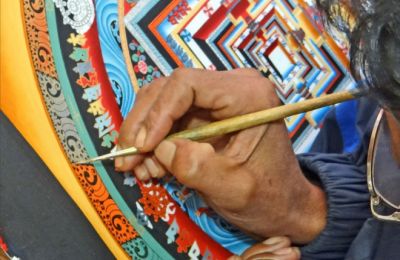
Thangka Painting Workshop and Sightseeing Tour - 1 day
Discover the traditional art of Thangka painting on a special tour in Kathmandu! Learn the techniques and craft your own masterpiece during a guided workshop and sightseeing tour.
Inquire Now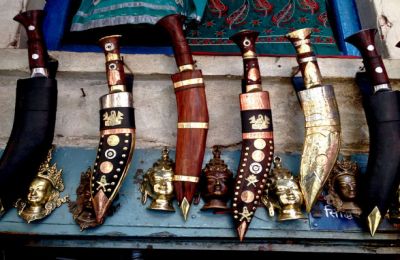
Khukuri Making Workshop in Kathmandu - 1 day
Looking for a unique cultural experience in Kathmandu? Our Khukuri making workshop offers a hands-on opportunity to learn about this traditional craft.
Inquire NowWhere to travel next?
Get help from our travel specialists for holiday ideas that matches your interests.
Rudraksha Beads
If you are a devout Hindu, then you will know the importance of Rudraksha beads. Nepal is one of the few countries in the world where rudraks ha trees grow. Rudraksha is known as the tears of Lord Shiva, and the beads are believed to possess miraculous properties. Wearing rudraksha beads is said to enhance mindfulness and bring positive changes to a person. The rudraksha trees grow at high altitudes along the foothills of the Himalayas, 2000 meters above sea level. The holy beads have mukhis, or ridges, which signifies their properties and importance.
Different Hindu deities are said to reside in different mukhis of rudraksha. While Lord Shiva is said to reside in the ek (one) and paanch (five) mukhi rudrakshas, Lord Kuber, the Hindu god of wealth, is said to reside in the 21 mukhi rudrakshas. The male and female (Shiva and Shakti) energies are trapped in the two mukhi rudrakshas and are recommended for marital harmony. If you want to enhance your creativity, wearing a char (four) mukhi rudraksha will bless you with a creative temperament, as Lord Brahma, the creator of the universe, is believed to reside in a char Mukhi rudraksha.
Saligram
Shaligrams are holy stones that are regarded as representations of Lord Vishnu, the preserver of the universe. Saligrams are fossil ammonites found only in the Kali Gandaki River in Muktinath, Nepal. Hindus worship the stone, as for them, the stone is a representation of Lord Vishnu. A shaligram stone has a spiral marking within it, which is actually the fossilized outer shell of the ammonite. In Hinduism, these spiral ridges represent Lord Vishnu's chakra, or the eternal cycle of creation, preservation, and ending of life.
According to Hindu mythology, Lord Vishnu was cursed by Tulasi Mata. The curse turned him into a black mountain. The rocks that break away from the mountain became shaligrams or ammonite stones. Since these stones hold the essence of Lord Vishnu, Hindus regard them as sacred objects. It is believed that worshipping a shaligram will usher in prosperity and harmony in one's life.
There are twenty-four different types of shaligrams found in the Kali Gandikai River. Each shaligram represents an avatar of Lord Vishnu. They are different in shape, size, and color. While aHayagriva shaligram is blue in color and has the shape of an elephant's trunk, the Gadadharasaligram is honey-colored and circular. The Trivikrama shaligram is black in color and has a triangle shape. Worshipping a Trivikrama saligram is said to bless the devotee with abundant wealth.
For a Hindu tourist on a pilgrimage tour to Nepal, a shaligram is a sacred souvenir that he or she can take back with him or her. Since shaligrams are found only in the Kali Gandaki River of Nepal, you can be assured of the authenticity of the sacred stone while buying it from Nepal.
Singing Bowl
Singing bowls are an important tool in the Tibetan style of meditation. Singing bowls are made of copper. brass or an alloy of seven different metals (gold, silver, iron, lead, copper, tin, and zinc, which represent the seven heavenly bodies). They have been used by Buddhist monks for meditation since time immemorial.
The singing bowl consists of a deep bowl and a mallet or wand which is used to produce the sound or vibrations. The vibrations created by the singing bowl help one to focus and enhance meditation power. The frequencies created by the singing bowl are also believed to improve your physical as well as your psychological health. Listening to the unique tone of a singing bowl helps you relax and removes toxic energies from your body. The vibrations are said to have healing properties and are beneficial for patients suffering from cardiac, respiratory, and spinal problems.
Singing bowls are sold at most tourist sites in Kathmandu and Pokhara. The bowls come in different sizes and price ranges.
Yarshagumba
Yarshagumba, or caterpillar fungus, is a rare medicinal fungus found in the high-altitude pastures of the Himalayas. It is prized for its aphrodisiac and medicinal properties. Also known as Himalayan Viagra, yarshagumba is known to be beneficial for curing respiratory and heart ailments, fatty liver, blood disorders, impotence, etc. It is rich in antioxidants and has anti-cancer properties.
Yarshagumba is pretty expensive, as it is found only in some areas. In Nepal, the caterpillar fungus grows in the alpine pastures of the Manaslu and Mustang regions. Since it is very difficult to harvest the fungus, its price is really high. However, you may have to pay a lot less if you purchase these edible fungi in Nepal. In the market, it is sold as medicinal capsules, powdered tea, and whiskey.
Hand-knotted woolen carpet and rug
One of the most popular items exported from Nepal is traditional hand-knotted woolen carpets and rugs. The carpets are made from sheep wool, which is dyed and then painstakingly hand-knotted by the carpet weavers. The Tibetan refugees who escaped from Tibet and came to Nepal during the Chinese invasion of Tibet brought the knowledge of hand-knotted carpet weaving with them. The first woolen carpets and rugs were produced at the Jwalakhel Tibetan Refugee Camp. Later, carpet and rug weaving became a huge industry as demand for these beautiful carpets grew. Now it is ranked as one of the top exports from Nepal.
There are many carpet showrooms across Kathmandu and Pokhara from which you can purchase a hand-knotted woolen rug or a carpet. The rugs and carpets come in a variety of patterns, colors, and sizes. You can choose a traditional motif or a modern design as per your taste. Most stores provide overseas shipping if you find the item too heavy to take it with you.
Dhaka
Dhaka is the traditional textile of Nepal. The Dhaka fabric is hand-woven on looms using colorful cotton or woolen yarns. The Dhaka fabric originated in the eastern hills of Nepal, where Limbu and Rai women used yarn made from the cotton grown in their fields to weave cloths. Terathum and Palpa are known as the production hubs of this beautiful fabric. The national costume of Nepal includes a Dhaka topi (cap), a chaubandi cholo, and a sari made from Dhaka fabric. A colorful Dhaka topi, Dhaka shawl, stole, muffler or handwoven Dhaka sari can be a great souvenir item that you can take back with you.
Made in Nepal clothes and footwear
Beyond the shops selling shapeless cotton and linen attire in Thamel, there are stores that sell locally made-premium-quality clothes, accessories, and footwear. With a little bit of research on the internet, you will be able to find shops where you can purchase Made in Nepal clothing and footwear. Dulla, Sonam Gears, Goldstar, Caliber, Juju Wears, etc. are some of the local brands that are known for their top-notch products.
Featured Trips
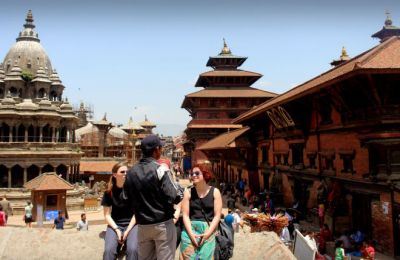
Kathmandu Ancient City Tour - 1 day
Our Kathmandu Ancient City Tour package includes full sightseeing of the medieval cities of Patan and Bhaktapur and the ancient Hindu temple of Changu Narayan. The sites that you will visit are listed in the UNESCO World Heritage Sites.
Inquire Now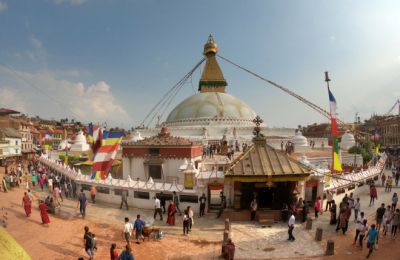
Kathmandu city tour with Nagarkot Sunrise and Dhulikhel Hiking - 2 days
Kathmandu city tour with Nagarkot sunrise and Dhulikhel hiking tour takes you to Nagarkot hill station and lets you hike through a popular hiking trail of Dhulikhel. You will explore the famous 4 UNESCO world heritage sites spread in Kathmandu
Inquire NowWhere to travel next?
Get help from our travel specialists for holiday ideas that matches your interests.
Mithila Art
Mithila art is a vibrant art form that originated in the Mithila Region of southern Nepal. Mithila art was originally created on the walls of mud houses by women who wanted to decorate their homes. Flour, twigs, cow dung, clay, and small sticks were used to draw figures of gods, goddesses, people, plants, and animals on their houses. These drawings are made during festivals, weddings, or pujas.
It is believed that the tradition of Mithila art first came into existence when King Janak, who ruled over the Mithila kingdom, asked his subjects to decorate their houses during the wedding of Lord Rama and Sita, King Janak's daughter. Since then, the women of the Mithila region have been decorating their homes with this unique art.
Mithila art is now regarded as an inherent part of Nepal's rich art and culture. From the mud walls of humble village homes, the art form now graces the walls of international art galleries, museums, and the homes of the rich and famous. This art has given economic independence to scores of village housewives, who now produce their art on paper and canvas instead of mud walls.
You can purchase a Mithila painting or an item (mirror, jewelry box, linen, pen stand, decoration piece, etc.) with Mithila art at any of the souvenir and handicraft stores.
Mask
Masks have an important value in Buddhist and Hindu tantric ceremonies. Masks are used in religious skits and cultural performances that are enacted to appease deities and spirits. Woodenandpapier-mâchémasks of various Buddhist deities are used in cham dances performed by monks in Buddhist monasteries. In Kathmandu, jatras, or chariot-pulling festivals, are incomplete without masked performances.
Religious masks are usually made from wood derived from the Bodhi or Peepal tree. Faces and designs are carved and painted on the mask by artisans who have learned the craft from a master mask maker. The masks are seasoned and dried before they make it to the shelves of a store. Having a traditional mask on the wall of your home will be a sweet reminder of your trip to Nepal.
There are a variety of masks you can choose from. You can either choose a religious mask depicting a Hindu or Buddhist deity like Bhairav, Lord Ganesh, or White Tara or a regular mask depicting a monk or a sadhu. You will find different masks on sale at almost all the tourist sites.
Marionettes
If you like collecting puppets, then you may want to add the tiny traditional marionettes crafted by Newari puppeteers to your collection. Known as 'Putali', these puppets depict Hindu and Buddhist gods. The puppets are dressed in bright, long skirts and wear two masks. While the marionettes are crafted by the artisans of Bhaktapur, they are sold at almost all the tourist sites in the valley.
Handmade Felt Products
Colorful handmade felt products like felt ball rugs, felt shoes, bags, purses, toys, etc. are great souvenir items. They are light and don't take up much space, making them easier for you to carry. Moreover, felt products in Nepal are usually crafted by underprivileged women and marginalized sections of society. So buying a felt item will, in a way, be your contribution towards a charitable cause.
Lokta Paper Products
LoktaPaper, or Nepali Kagaz, is a traditional Nepalese paper that is made from the bark of the Daphne bush. Lokta paper has been in use for hundreds of years. It was used to write sacred scriptures and government records. The oldest surviving Lokta manuscript found in Nepal is the Karanya Buha Sutra, a sacred Buddhist manuscript dating back to the Lichhavi period(450–750 CE). The document is preserved at Nepal's National Archives. Lokta paper was quite popular before the advent of cheap machine-made papers from India. While its popularity has waned, Lokta paper is still used in government offices in Nepal.
Lokta paper is a better alternative to standard paper as it is durable, water-resistant, and insect-resistant. Unlike standard paper, which poses a threat to the environment as the trees are cut to produce it, Lokta paper is made from a bush found abundantly in the foothills of the Himalayas. The daphne bush regenerates quickly after it is cut. So lokta paper production does not pose any significant threats to the environment.
You will find several products made from Lokta paper at the market: notebooks, sketchpads, paintings, cards, bags, gift wrapping paper, lamps, photo frames, wall hangings, etc. Lokta paper bags are also great for storing spices and incense as the potency of spices, medications, and incense is retained for a longer amount of time in paper bags manufactured using Lokta paper. An item made from Lokta papers makes for a great souvenir or gift from Nepal.
Titaura
Savory candies made from indigenous berries and fruits are a must-buy. Known as'titaura' or 'pau' these savory candies are made from hog plum, gooseberries, tamarind, raw mangoes, ginger, lime, etc. They are prepared by boiling and mixing them with sugar, jaggery, and chili flakes. These gooey mixtures are sun-dried and dehydrated. They are later cut into small pieces and sold. Titaura has a sweet, sour, and spicy taste and is a great antidote for motion sickness. Sold in small plastic packets, these candies can be purchased from small shops or supermarkets.
Churpi
Churpi or hardened yak cheese, is a Himalayan delicacy made from the buttermilk of ayak. The cheese is prepared by squeezing out the liquid from the buttermilk and drying the solid part. A churpi is hard like a rock, but it starts to soften after it's kept in the mouth for a long time. Chewing a churpi keeps one warm in the cold Himalayan climate. It has a subtle smoky flavor and tastes really good when it's about to finish. Churpi is a unique item from Nepal that you can gift to your friends and family.
Mustang's Apple Cider and Apple Brandy
Mustang is the apple capital of Nepal. The high-altitude hills, villages, and hamlets that fall in the Thak Khola area of Mustang are famous for their abundant apple orchards. Marpha in particular and its surrounding areas are the top growers of alleles in the country. Come apple season, the orchards in these villages are laden with ripe crimson-colored apples. The locals use apples to make apple cider, apple brandy, apple wine, and a variety of dishes (apple pies, apple crumble, etc.). The locally made, sun-dried peeled apples are also quite delicious and last for a long time.
If you happen to trek to Mustang, you should certainly purchase one of the products made from the local apples as a souvenir item.
Yak Cheese
Yaks are found only in the Himalayan region. The high Himalayan ethnic groups like the Sherpas and Bhotias domesticate these hairy creatures and use their milk, meat, and dung to sustain themselves in the difficult high-altitude environment. Yak cheese, made from the milk of yaks, is a Himalayan delicacy.
Himalayan French Cheese, the brainchild of French fromager Francois Driard, has created some prize-winning cheese using yak milk. His Yak Blue Cheese produced in Ramechhap won a gold medal at a cheese-making competition in France that featured over nine hundred varieties of cheese from forty-eight countries.
In Kathmandu, you can purchase yak cheese from DDC dairy outlets and the Himalayan French cheese outlets. You can also find these rare cheeses on sale at the farmer's markets in the city. There's a yak cheese factory in Kyangjin Gompa in Langtang, established by the Swiss government during the 1950s. It's still in operation, and you can purchase yak cheese if you happen to trek to the Langtang Valley.
Conclusion
Shopping for souvenirs in Nepal can be a delightful experience. There are so many items you can choose from, and you can spend a whole day exploring the local markets and tourist hubs in souvenir hunting. In Kathmandu, Thamel is a prime area to shop for souvenirs. As it is a tourist hub, the streets are lined with various shops selling all kinds of handicrafts and souvenir items. From paintings to masks and clothes, you can find almost anything here. Ason Bazaar, New Road, Durbar Marg, Jwalakhel, Mangalbazar, and Bhaktapur are some of the other shopping hubs in the capital. In Pokhara, the Lakeside area has plenty of shops selling souvenir items and trekking gear. Small towns and villages have bazaars and weekend markets where local specialties are sold.
- Written by: Naba Raj Amgai
Updated: Feb, 5, 2024

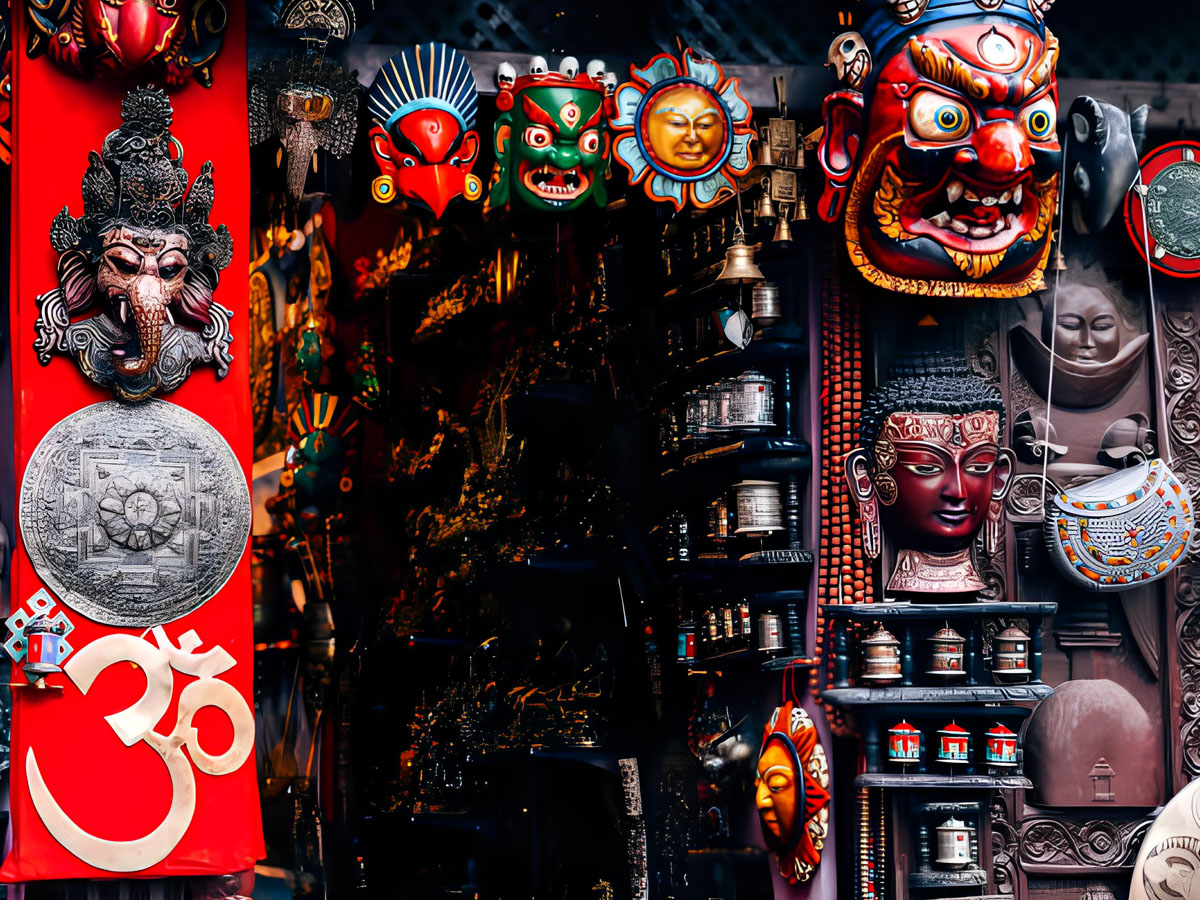

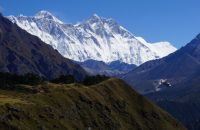
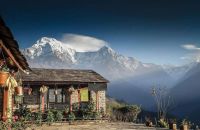
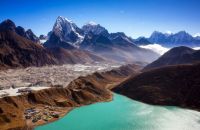
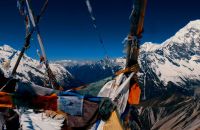
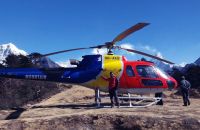





.jpegXkO.jpeg&width=200&height=130)









